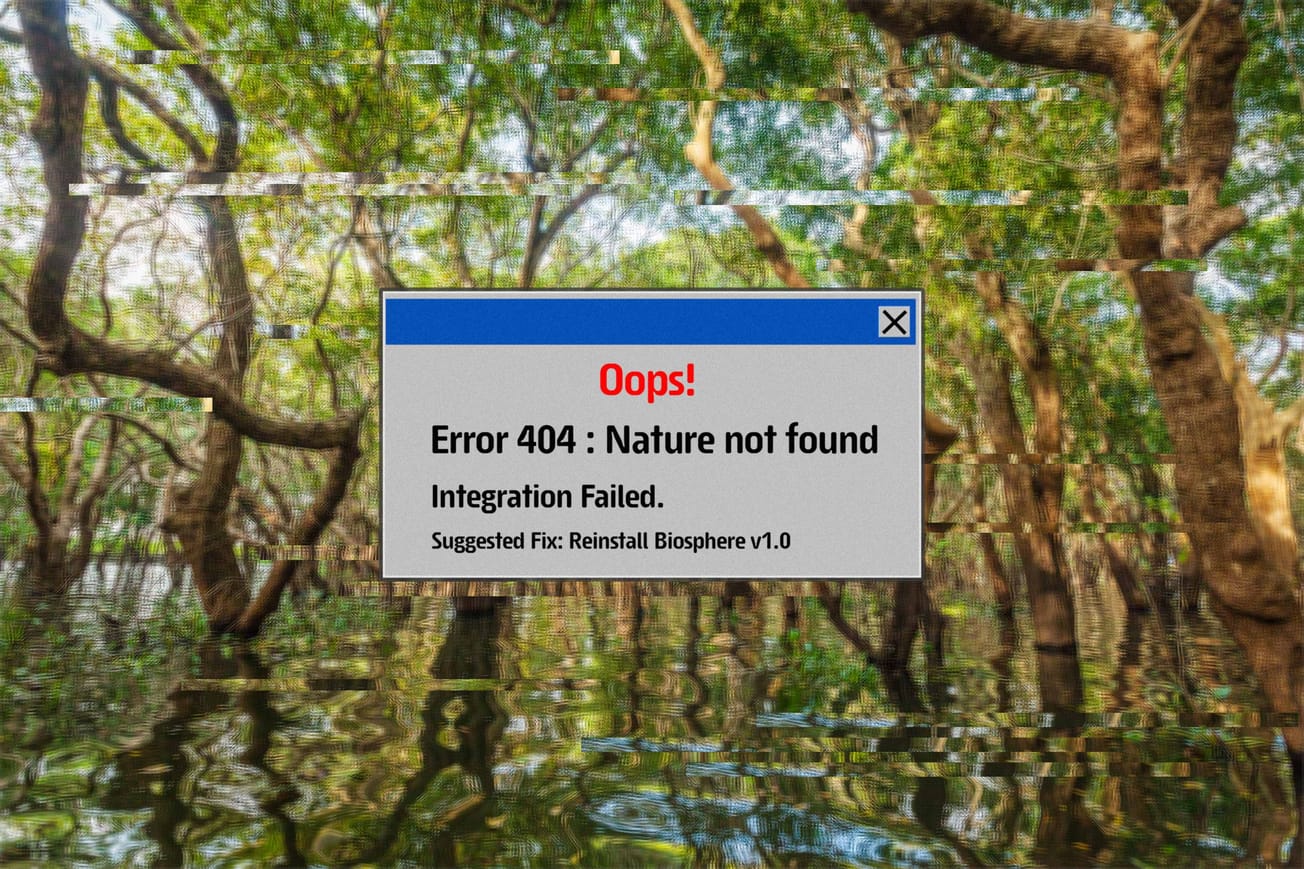The narrative around global warming is often framed as a crisis of rising temperatures, melting ice caps, and increasingly severe weather patterns—all primarily driven by the unchecked emissions of carbon dioxide (CO2) from human activity. However, global warming is not just an isolated environmental issue; it is symptomatic of a broader and more profound set of challenges rooted in the very fabric of modern industrial society. The deterioration of our external environment directly reflects the degradation of our internal biology and mental health. The health of our planet is inextricably linked to human well-being, with the condition of nature serving as a mirror to our own internal state. This dual crisis highlights the unsustainable trajectory of our current way of life and calls for a holistic reevaluation of how we interact with both the planet and ourselves.
The Environmental Consequences of Industrial Society
Global warming, driven largely by the burning of fossil fuels, deforestation, and industrial agriculture, is one of the most visible and immediate consequences of modern industrial society, resulting in more frequent and severe heatwaves, rising sea levels, and shifts in ecosystems that are significantly diminishing biodiversity and challenging food security.
However, the environmental consequences of industrial society extend far beyond climate change. Air pollution, largely a byproduct of burning fossil fuels, is responsible for shortening the average global life expectancy by nearly three years, according to a 2020 study published in Cardiovascular Research. The World Health Organization (WHO) estimates that air pollution causes 7 million premature deaths annually, with particulate matter (PM2.5) linked to heart disease, stroke, lung cancer, and respiratory infections. The same industrial processes that emit CO2 also release a cocktail of other harmful pollutants, including nitrogen oxides, sulfur dioxide, and volatile organic compounds, all of which contribute to the degradation of air quality and human health.
Moreover, the extensive use of synthetic chemicals in agriculture, manufacturing, and consumer products has led to widespread contamination of soil, water, and food. For example, humans are now ingesting significant amounts of microplastics daily. According to research published in Environmental Science & Technology, Americans consume an estimated 39,000 to 52,000 microplastic particles annually through food and beverages (Cox, K. D., et al., 2019). This estimate increases to 74,000 to 121,000 particles when including inhalation of microplastics from the air. A report from the World Wildlife Fund (WWF) further suggests that individuals may ingest about 5 grams of microplastics per week—roughly equivalent to the weight of a credit card.
The Internal Costs: Biological and Mental Health Degradation
The degradation of our external environment is paralleled by the degradation of our internal biology and mental health. The chemicals that permeate our air, water, and food are not just harmful to ecosystems; they are also toxic to human health. In addition to microplastics, there are numerous other potentially harmful chemicals that Americans regularly encounter through food, air, and skin contact. These chemicals have various adverse effects on health, ranging from acute toxicity to long-term impacts like cancer, endocrine disruption, and neurological damage
The rise in chronic diseases—such as cancer, diabetes, and cardiovascular disease—can be traced back to environmental factors exacerbated by industrial society. A study published in The Lancet in 2020 identified pollution as a leading cause of death, responsible for 9 million premature deaths worldwide in 2015, or 16% of all deaths globally. This toll is comparable to that of smoking, and more than three times that of AIDS, tuberculosis, and malaria combined. The majority of these deaths are due to non-communicable diseases directly linked to pollution, such as heart disease, stroke, lung cancer, and chronic obstructive pulmonary disease (COPD).
Mental health, too, is being undermined by the stresses and dislocations of modern life. The World Health Organization reports that depression is now the leading cause of disability worldwide, affecting more than 264 million people. Anxiety disorders, which often co-occur with depression, are similarly rising rapidly, particularly in industrialized nations. The disconnection from nature—often termed "nature-deficit disorder"—is increasingly recognized as a contributing factor to the mental health crisis.
The mental health crisis is further compounded by substance use disorders, which affect a significant portion of the population. An estimated 20-25% of American adults are impacted by substance use disorders, whether it be alcohol, illicit drugs, or prescription medication misuse. The increase in prescription medications for mental health conditions, such as antidepressants and anti-anxiety drugs, is a telling indicator of the crisis. According to the Centers for Disease Control and Prevention (CDC), nearly 13% of Americans aged 12 and older used antidepressants in the past month, with the use of anti-anxiety medications also widespread. However, these medications often treat symptoms rather than underlying causes, leading to concerns about dependency and the broader implications of medicating large swathes of the population for stress, anxiety, and depression—conditions that are exacerbated by the very nature of modern industrial life.
A Feedback Loop of Destruction
The degradation of our environment and our health are not isolated phenomena; they are part of a feedback loop that threatens to spiral out of control. As our environment becomes more toxic, our bodies accumulate more pollutants, leading to a higher incidence of disease and a greater reliance on healthcare systems already stretched thin. At the same time, the mental health crisis fueled by industrial society's pressures—work, consumption, social isolation—drives behaviors that further harm the environment, such as overconsumption and the use of harmful products. This, in turn, exacerbates environmental degradation, creating a vicious cycle.
Consider the role of industrial agriculture, which is both a major contributor to global warming and a source of widespread chemical contamination. The heavy use of fertilizers, pesticides, and herbicides not only pollutes water and soil but also contributes to the loss of biodiversity and the degradation of ecosystems that are vital for carbon sequestration. At the same time, the industrial food system produces cheap, calorie-dense, nutrient-poor foods that contribute to the rise in obesity, diabetes, and other chronic diseases. The global shift towards processed foods high in sugar, fat, and salt—a hallmark of industrial society—is a key driver of these health epidemics.
The Need for a Holistic Approach
Addressing global warming requires more than just reducing carbon emissions; it necessitates a fundamental rethinking of our relationship with the planet and ourselves. The current focus on technological solutions—such as carbon capture and storage, or geoengineering—risks treating symptoms rather than the underlying disease. Without addressing the broader issues of environmental degradation and human health, these solutions may prove to be little more than temporary fixes that simply lead to potentially insurmountable future challenges.
A truly sustainable future will require a holistic approach that considers the health of the planet and its inhabitants as interconnected. This means not only transitioning to renewable energy sources and reducing pollution but also restoring ecosystems, reducing chemical exposures, and promoting mental health through greater connection to nature. It also means rethinking the economic and social systems that drive overconsumption and environmental destruction, and that prioritize short-term profits over long-term well-being.
One promising avenue is the growing movement towards regenerative agriculture, which seeks to restore soil health, increase biodiversity, and sequester carbon while producing nutritious food. Another is the push for green urbanism, which aims to create cities that are more sustainable, resilient, and connected to nature. On the personal level, lifestyle changes that prioritize minimalism, wellness, and a connection to the natural world can help break the cycle of consumption and mental health degradation.
Conclusion
Global warming, driven by carbon emissions, is a symptom of a larger set of issues rooted in the structure of modern industrial society. The same processes that are warming the planet are also degrading our internal biology and mental health, creating a feedback loop that threatens both the environment and human well-being. Addressing this crisis requires a holistic approach that goes beyond technological fixes and considers the health of both the planet and its inhabitants as deeply interconnected. By rethinking our relationship with nature, reducing our reliance on harmful chemicals, and promoting mental health through greater connection to the natural world, we can begin to heal both the planet and ourselves.
Sources:
- Cox, K. D., et al. (2019). "Human Consumption of Microplastics." Environmental Science & Technology. National Institutes of Health (NIH).
- World Health Organization (WHO).
- Centers for Disease Control and Prevention (CDC).
- Environmental Working Group (EWG).
- Journal of Environmental Economics and Management (2022).
- Intergovernmental Panel on Climate Change (IPCC).
- The Lancet (2020).













